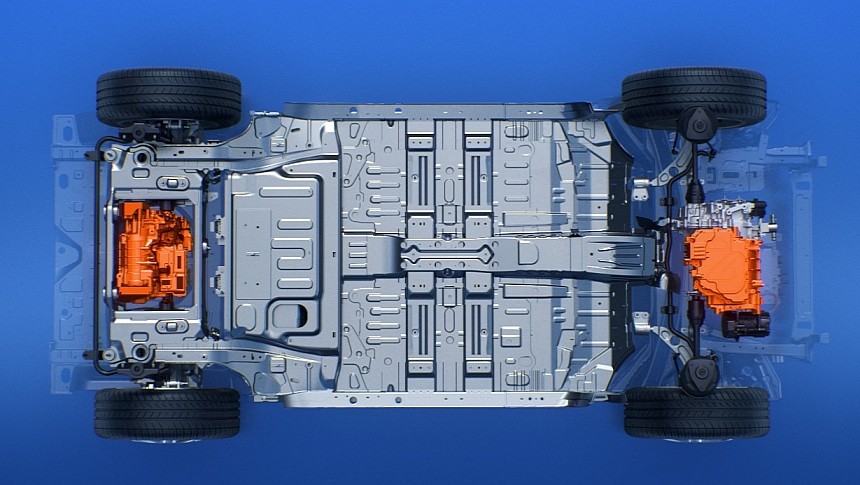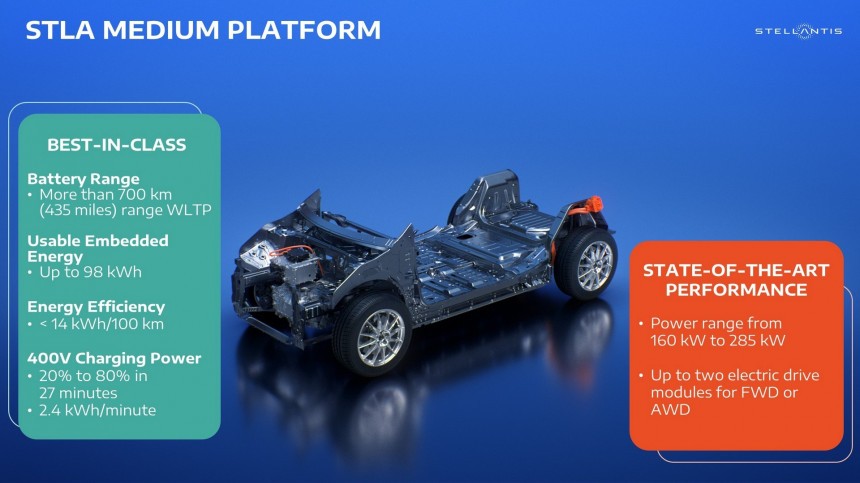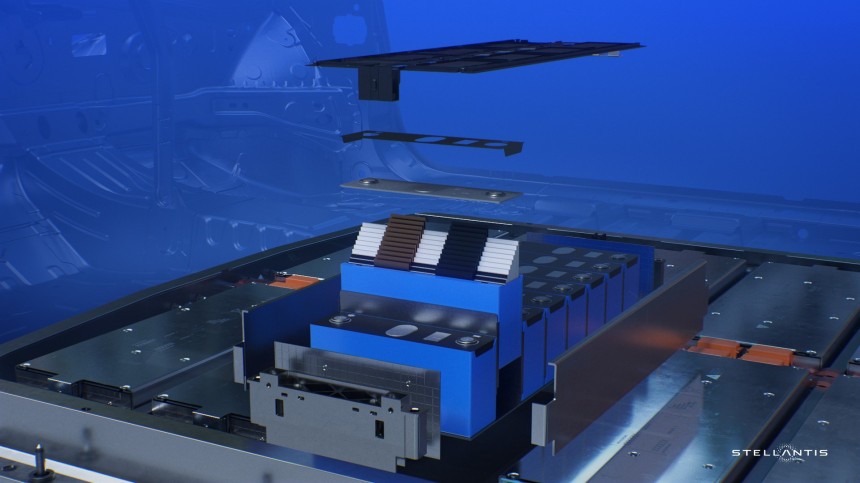In July 2021, the Stellantis EV Day revealed the four platforms the automaker would use in its electrification efforts: STLA Small, Medium, Large, and Frame. It also shared some technical parameters it would follow that we now know have changed a bit, at least in what relates to the first architecture to reach production lines: the STLA Medium. Stellantis said it will offer up to 435 miles (700 kilometers) of range but will only work at 400V.
That is a serious setback for the products based on it, especially as the Hyundai group offers relatively affordable C-segment battery electric vehicles (BEVs) with 800V, such as the Hyundai IONIQ 5 and IONIQ 6, Kia EV6 and Genesis GV60. The higher the voltage, the quicker these cars can charge their battery packs – and Stellantis must know that.
The company said owners of these future STLA Medium cars would have up to 98 kWh and take their vehicles from 20% to 80% of charge in 27 minutes. Stellantis did not disclose the charging speed it can handle nor the battery pack size that demands that much time to fast charge. Compare that to what the IONIQ 5 achieves, and you'll see Stellantis is announcing future products that will already hit the market outdated.
Hyundai's electric SUV demands a 350-kW charger to go from 10% to 80% of change in 18 minutes. Its most prominent battery pack option has 77.4 kWh to offer, but let's imagine an STLA Medium product with a similarly sized high-voltage accumulator and that the time Stellantis disclosed refers to such a BEV. To make a comparison possible, suppose both vehicles present the same range: 300 miles (482.8 km).
For the STLA Medium vehicle to go from 20% to 80% of capacity, that would mean it had 60 miles (96.6 km) of range left and that the fast charger raised that to 240 miles (386.2 km). In 27 minutes, the BEV would have recovered only 180 miles (289.7 km) of range. The IONIQ 5 goes from 10% to 80% in 18 minutes. That means it goes from 30 to 240 miles of range if you wait that long.
While that may not seem that much of a difference, you should look at the bigger picture. Imagine a 500-mile (804.7-km) trip. In our hypothetical STLA Medium vehicle, you'll have to stop earlier to charge – after running 240 miles. Waiting 27 minutes will theoretically give you 240 miles more to drive, which would force you to stop again for a fast charge, but it is worse than that: you'll only spend 27 minutes charging if you stop with 20% charge left (60 miles). In other words, you'll only drive 180 miles more before needing another fast charge. Your trip will still demand 80 miles (128.8 km) to end, and you'll have wasted 54 minutes just recharging.
In the Hyundai IONIQ 5, you'll drive 270 miles (434.5 km) before needing to stop with 10% of charge left (30 miles, or 48.3 km). In 18 minutes, you'll recover 240 miles of range, which is enough to reach your destination if you do not feel anxious to have only 10 miles (16.1 km) left of range. Supposing the weather is warm and you have no hills to beat, the same trip demands 18 minutes instead of 54. That's what an 800V system represents over one that works at 400V.
Remember that this is only possible with a 350-kW charger for the Hyundai, but at least it can take that much charging speed if it is available. That is not possible for a vehicle with the STLA Medium platform. If Stellantis wants it to sell well, it will need a strong price appeal. The good news is that these future vehicles will be as energy-efficient as the Lucid Air: 4.4 miles/kWh (7.1 km/kWh, or 14 km per 100 km).
In July 2021, Stellantis said its C- and D-segment cars would have battery packs of up to 104 kWh based on this architecture. Could it offer 98 kWh of usable capacity and 6 kWh of buffering? The automaker did not clarify that, but the available information suggests only that the plans changed.
Despite its obvious shortcomings, the STLA Medium platform should underpin two million BEVs per year under its 14 brands. Currently, the company sells 26 nameplates in these market segments. Outputs should range from 160 kW (215 hp) to 285 kW (382 hp) in front-wheel drive (FWD) or all-wheel drive (AWD) derivatives.
The vehicles' lengths will go from 4.3 meters (169.3 inches) to 4.9 m (192.9 in), while wheelbases will range from 2.70 m (106.3 in) to 2.90 m (114.2 in). Ground clearances of up to 220 millimeters (8.7 in) ensure Jeep vehicles are also included among those that may use this architecture.
With the 14-brand stable Stellantis controls, we will undoubtedly see remarkable vehicles emerge from the STLA Medium in all countries where Stellantis sells its cars. However, when two of the main pillars of the EV game are low fast charging times and hassle-free trips, they will arrive with a flagrant handicap. If Stellantis does not know that by now, it will learn about that in a harsh fashion.
The company said owners of these future STLA Medium cars would have up to 98 kWh and take their vehicles from 20% to 80% of charge in 27 minutes. Stellantis did not disclose the charging speed it can handle nor the battery pack size that demands that much time to fast charge. Compare that to what the IONIQ 5 achieves, and you'll see Stellantis is announcing future products that will already hit the market outdated.
Hyundai's electric SUV demands a 350-kW charger to go from 10% to 80% of change in 18 minutes. Its most prominent battery pack option has 77.4 kWh to offer, but let's imagine an STLA Medium product with a similarly sized high-voltage accumulator and that the time Stellantis disclosed refers to such a BEV. To make a comparison possible, suppose both vehicles present the same range: 300 miles (482.8 km).
While that may not seem that much of a difference, you should look at the bigger picture. Imagine a 500-mile (804.7-km) trip. In our hypothetical STLA Medium vehicle, you'll have to stop earlier to charge – after running 240 miles. Waiting 27 minutes will theoretically give you 240 miles more to drive, which would force you to stop again for a fast charge, but it is worse than that: you'll only spend 27 minutes charging if you stop with 20% charge left (60 miles). In other words, you'll only drive 180 miles more before needing another fast charge. Your trip will still demand 80 miles (128.8 km) to end, and you'll have wasted 54 minutes just recharging.
In the Hyundai IONIQ 5, you'll drive 270 miles (434.5 km) before needing to stop with 10% of charge left (30 miles, or 48.3 km). In 18 minutes, you'll recover 240 miles of range, which is enough to reach your destination if you do not feel anxious to have only 10 miles (16.1 km) left of range. Supposing the weather is warm and you have no hills to beat, the same trip demands 18 minutes instead of 54. That's what an 800V system represents over one that works at 400V.
In July 2021, Stellantis said its C- and D-segment cars would have battery packs of up to 104 kWh based on this architecture. Could it offer 98 kWh of usable capacity and 6 kWh of buffering? The automaker did not clarify that, but the available information suggests only that the plans changed.
Despite its obvious shortcomings, the STLA Medium platform should underpin two million BEVs per year under its 14 brands. Currently, the company sells 26 nameplates in these market segments. Outputs should range from 160 kW (215 hp) to 285 kW (382 hp) in front-wheel drive (FWD) or all-wheel drive (AWD) derivatives.
With the 14-brand stable Stellantis controls, we will undoubtedly see remarkable vehicles emerge from the STLA Medium in all countries where Stellantis sells its cars. However, when two of the main pillars of the EV game are low fast charging times and hassle-free trips, they will arrive with a flagrant handicap. If Stellantis does not know that by now, it will learn about that in a harsh fashion.












